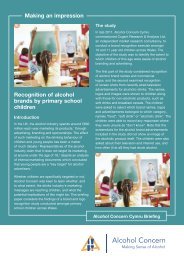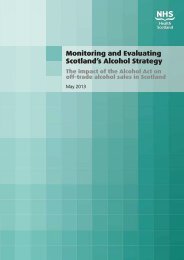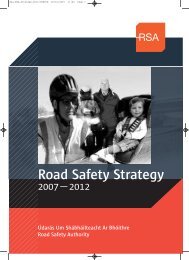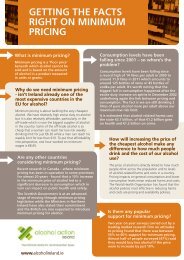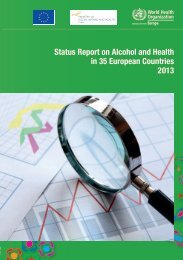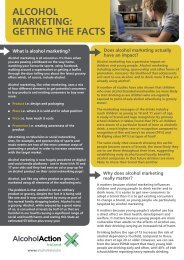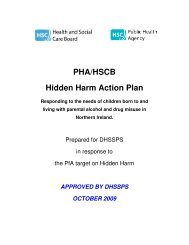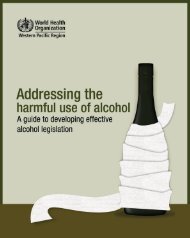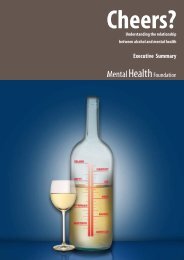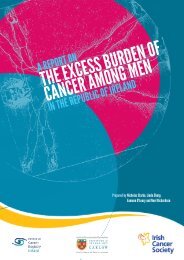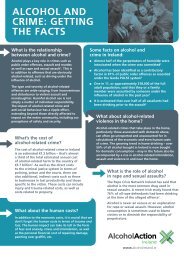Who pre-drinks before a night out and why? - Alcohol Action Ireland
Who pre-drinks before a night out and why? - Alcohol Action Ireland
Who pre-drinks before a night out and why? - Alcohol Action Ireland
Create successful ePaper yourself
Turn your PDF publications into a flip-book with our unique Google optimized e-Paper software.
http://informahealthcare.com/jsuISSN: 1465-9891 (print), 1475-9942 (electronic)J Subst Use, Early Online: 1–10! 2013 Informa UK Ltd. DOI: 10.3109/14659891.2013.784368ORIGINAL ARTICLE<strong>Who</strong> <strong>pre</strong>-<strong>drinks</strong> <strong>before</strong> a <strong>night</strong> <strong>out</strong> <strong>and</strong> <strong>why</strong>? Socioeconomic status <strong>and</strong>motives behind young people’s <strong>pre</strong>-drinking in the United KingdomJeanette Østergaard 1 <strong>and</strong> Stefan Bastholm Andrade 21 SFI – The Danish National Centre For Social Research, Copenhagen, Denmark <strong>and</strong> 2 Department of Sociology, University of Copenhagen,Copenhagen, DenmarkJ Subst Use Downloaded from informahealthcare.com by 80.198.89.98 on 07/15/13For personal use only.AbstractAim: To examine young people’s main motive for <strong>pre</strong>-drinking in the United Kingdom, howmuch they drink on an event-specific <strong>night</strong> <strong>out</strong>, <strong>and</strong> whether motives or socioeconomic status(particularly their income level) explain the alcohol quantities they drink. Methods: Multilevellogit <strong>and</strong> Poisson models were used on a survey of 628 people (aged 18–35) conducted on-sitein 26 bars, clubs <strong>and</strong> pubs in four cities <strong>and</strong> towns. Results: Young males drink on average 9.8<strong>and</strong> females 7.4 st<strong>and</strong>ard units of alcohol <strong>before</strong> a <strong>night</strong> <strong>out</strong>. Saving money is the most<strong>pre</strong>valent motive for <strong>pre</strong>-drinking. Although lower income levels cannot explain whether ayoung person will <strong>pre</strong>-drink on an event-specific <strong>night</strong> <strong>out</strong>, young people’s income level <strong>and</strong>their motives explain the quantities they consume. Lower-earning males who <strong>pre</strong>-drank to savemoney consumed larger quantities of alcohol at home <strong>and</strong> lower-earning females also <strong>pre</strong>dranklarger quantities either because they wanted to get <strong>out</strong> of control or because theywanted to be social. Conclusions: Prevention strategies likely to be effective in reducing thealcohol quantities that young people <strong>pre</strong>-drink should take into account both socioeconomicstatus <strong>and</strong> motives for <strong>pre</strong>-drinking.IntroductionThe act of drinking <strong>before</strong> going <strong>out</strong> to a pub, bar or club hasdrawn increasingly more attention amongst alcohol <strong>and</strong> drugresearchers in the UK (Hughes et al., 2007; Wells et al.,2008), Switzerl<strong>and</strong> (Labhart et al., 2013) <strong>and</strong> the US(Pedersen & LaBrie, 2007; Pedersen et al., 2009). Thisphenomenon – also known as ‘‘<strong>pre</strong>-loading’’, ‘‘<strong>pre</strong>-gaming’’,‘‘front-loading’’ or ‘‘prinks’’ – involves heavy consumptionof alcohol within a short period, usually at a private residence,causing great concern for both short-term <strong>and</strong> long-termhealth risks. Short-term risk factors include sudden highalcohol levels in the blood, increasing the risk of black<strong>out</strong>s(LaBrie et al., 2011), alcohol poisoning (LaBrie & Pedersen,2008) <strong>and</strong> violence (Borsari et al., 2007). Pre-drinking <strong>before</strong>going to a main event (e.g. clubs, bars or concerts) is alsocorrelated with heavier drinking later in the evening(Pedersen & LaBrie, 2007).Qualitative studies suggest that young people <strong>pre</strong>-drink<strong>before</strong> a main <strong>night</strong> <strong>out</strong> with the explicit intention ofintoxication (DeJong & DeRicco, 2010; Forsyth, 2010).This finding has led researchers to define <strong>pre</strong>-drinkingas ‘‘rapid consumption of alcohol done with the intentionCorrespondence: Jeanette Østergaard, SFI – The Danish National CentreFor Social Research, Copenhagen, Denmark. E-mail: jea@sfi.dkKeywords<strong>Alcohol</strong>, binge-drinking, motives, policy(policies), <strong>pre</strong>-drinkingHistoryReceived 3 September 2012Revised 17 February 2013Accepted 19 February 2013Published online 12 July 2013of reaching a sufficient level of intoxication to carryone through the main event of the evening with minimalfurther spending on alcohol’’ (Wells et al., 2009, p. 10).The definition assumes that <strong>pre</strong>-drinking is primarily drivenby young people’s motives to save money by not havingto buy as much expensive alcohol in bars <strong>and</strong> club.However, no survey study has yet examined whether ornot young people’s primary motive for <strong>pre</strong>-drinking is tosave money.This study investigates young people’s motives for <strong>pre</strong>drinkingin a convenient sample of 18-to-35-year-old visitorsto 26 bars, pubs <strong>and</strong> clubs in four different cities <strong>and</strong> towns inthe UK, a nation famous for its very high level of alcoholconsumption amongst young people (Eurobarometer, 2004,2007; Robinson & Harris, 2011). The survey features thelargest number of venues <strong>and</strong> the biggest sample sizecollected in one single UK study that targets the hard-toreach-groupof <strong>pre</strong>-drinking club- <strong>and</strong> bar-goers in fourdifferent regions: North West Engl<strong>and</strong>, East of Engl<strong>and</strong>,S<strong>out</strong>h East Engl<strong>and</strong> <strong>and</strong> London. Our aim is also to examinewhether young people’s socioeconomic status is a significantfactor in explaining whether young people <strong>pre</strong>-drink <strong>and</strong> howmuch alcohol they consume <strong>pre</strong>-drinking. As research on theassociations between socioeconomic status <strong>and</strong> people’sdrinking patterns has been inconsistent (Caldwell et al.,2008; Jefferis et al., 2007; Laatikainen et al., 2003),the analysis controls for socioeconomic status according to2013
2 J. Østergaard & S. B. Andrade J Subst Use, Early Online: 1–10J Subst Use Downloaded from informahealthcare.com by 80.198.89.98 on 07/15/13For personal use only.three separate factors (employment status, education <strong>and</strong>income level).The <strong>pre</strong>valence of <strong>pre</strong>-drinking amongst young people inthe UK has been documented in several studies. In a study infour cities <strong>and</strong> towns in the Lancashire area, 66% of females<strong>and</strong> 49% of males aged 16–51 reported <strong>pre</strong>-drinking on the<strong>night</strong> of the survey (Measham et al., 2011b). Likewise, in arecent study from Liverpool, also in the same region,researchers found that 70% of females <strong>and</strong> 51% of maleswere <strong>pre</strong>-drinking on the <strong>night</strong> of the survey (Hughes et al.,2011). However, a study from London revealed that only 28%of females <strong>and</strong> 27% of males reported <strong>pre</strong>-drinking on the<strong>night</strong> of survey (Hadfield et al., 2010). The three studies usedsimilar questions to capture <strong>pre</strong>-drinking – namely whetheryoung people had been drinking alcohol at home or at afriend’s house <strong>before</strong> going <strong>out</strong> – <strong>and</strong> thus they suggest the<strong>pre</strong>valence of regional differences in terms of how wides<strong>pre</strong>ad<strong>pre</strong>-drinking is in the UK.In the US, <strong>pre</strong>-drinking has been studied mainly as aphenomenon <strong>pre</strong>valent amongst college students under thelegal drinking age of 21 (DeJong & DeRicco, 2010). A studyconducted in a student-dominated downtown area in Virginiafound that amongst r<strong>and</strong>omly selected late-<strong>night</strong> pedestrians,69% reported <strong>pre</strong>-drinking, <strong>and</strong> that <strong>pre</strong>-drinking was most<strong>pre</strong>valent amongst under-age drinkers (Glindemann et al.,2006). A study of American psychology students showedthat 64% reported <strong>pre</strong>-drinking <strong>before</strong> going <strong>out</strong> to a mainevent <strong>and</strong> that social motives – drinking with friends<strong>and</strong> room-mates in a social setting – explained only ab<strong>out</strong>15%–21% of the young people’s <strong>pre</strong>-drinking. Youngpeople’s motives, however, could not explain the quantityof alcohol consumed during <strong>pre</strong>-drinking (Pedersen &LaBrie, 2007). A focus group discussion amongstAmerican college students revealed that many students sawthemselves as drinking more heavily <strong>before</strong> going <strong>out</strong> ifalcohol would be less accessible or too costly later in theevening (DeJong & DeRicco, 2010).That young people consume alcohol for different motives,depending on the social context (Cox & Klinger, 1988;Edwards et al., 1973; Jung, 1977), is well established. Studieshave revealed how enhancement motives (e.g. drinking to feelgood or enhance confidence) are most strongly associatedwith heavy drinking; social motives (to be sociable <strong>and</strong> havea good time), with moderate drinking; <strong>and</strong> coping motives(to escape, relieve stress or avoid social rejection), withproblematic drinking (Kuntsche et al., 2005). However, youngpeople’s motives for drinking are likely to differ acrossdifferent setting in which they drink, <strong>and</strong> these differentmotives have rarely been surveyed. One exception is a studyof young Hungarian adults, finding that social motives are themain reason for young people’s consuming alcohol at festivals(Németh et al., 2011).For creating new <strong>pre</strong>vention strategies, a further underst<strong>and</strong>ingof young people’s event- <strong>and</strong> context-specificdrinking patterns is necessary (Neighbors et al., 2007).Different recreational settings (e.g. a concert, house party,club or bar) are most likely to be associated with differenttypes of motives for drinking, just as young people’s <strong>pre</strong>drinkingmotives are likely to be affected by the characteristicsof the main event of the evening. Qualitative studieshave suggested that a number of different motives are at stakein explaining young people’s reason for <strong>pre</strong>-drinking: savingmoney, getting a buzz or getting wasted; socializing withfriends; or reducing the <strong>pre</strong>ssure, stress <strong>and</strong> anxiety of going<strong>out</strong> with friends (DeJong & DeRicco, 2010; Forsyth, 2010).Other studies amongst heterosexual males have found that themain motive for <strong>pre</strong>-drinking is to establish male bonding(Grazian, 2007). Individual-focused <strong>pre</strong>vention interventionsfocusing on event-specific heavy alcohol consumption such asmotivational interviewing (Cronce & Larimer, 2011) couldbenefit from assessments of young people’s event-specific<strong>pre</strong>-drinking motives, especially as the <strong>pre</strong>-drinking phenomenonis becoming more wides<strong>pre</strong>ad, particularly in NorthWest Engl<strong>and</strong> (Hughes et al., 2007, 2011).Young people’s increased interest in <strong>pre</strong>-drinking (largeamounts of alcohol) must be approached within the context ofan exp<strong>and</strong>ing UK <strong>night</strong>-time economy, in which upgradedcorporate <strong>night</strong>-life spaces such as the café <strong>and</strong> ‘‘style bars’’target professionals, higher- <strong>and</strong> lower-level service sectorworkers (e.g. social workers <strong>and</strong> nurses, or hairdressers <strong>and</strong>clerical workers, respectively), <strong>and</strong> students (Chatterton &Holl<strong>and</strong>s, 2002). Whilst traditional pubs serve the purpose of‘‘going <strong>out</strong> for a drink’’, many of the new corporately ownedmainstream bars, pubs <strong>and</strong> <strong>night</strong>clubs encourage the idea ofdrinking to intoxication. With promotions such as ‘‘happyhour’’, ‘‘all-you-can-drink (for £10)’’ <strong>and</strong> inexpensive alcohol(Meier, 2011), these mainstream places have grown inpopularity as young people drink alcohol with the explicitintention of reaching high levels of intoxication, also definedas ‘‘determined drunkenness’’ (Brain et al., 2000; Measham,2006; Measham & Brain, 2005).If determined drunkenness has become young people’sperceived norm for how to consume alcohol on a <strong>night</strong> <strong>out</strong>,<strong>pre</strong>-drinking larger quantities of alcohol should be more<strong>pre</strong>valent amongst lower-income young people who, despitehappy hour <strong>and</strong> all-you-can-drink-offers, will have fewermeans of participating in on-<strong>pre</strong>mises intoxication-relateddrinking. No study has yet examined the association betweenyoung people’s <strong>pre</strong>-drinking quantities <strong>and</strong> their level ofincome, <strong>and</strong> few studies have examined the associationbetween young people’s overall drinking patterns <strong>and</strong> theirsocioeconomic status. One exception is a longitudinal studyby Casswell et al. (2003), which followed young people’soverall drinking patterns (i.e. not surveyed in situ) at ages 18,21 <strong>and</strong> 26. It found that at all ages, less educated youngpeople were drinking larger quantities on specific drinkingoccasions, whereas the frequency of drinking was associatedwith high income levels. That less well-educated youngpeople are more likely to drink larger quantities during adrinking session suggests that the less well-educated youngpeople are the more sensation-seeking <strong>and</strong> risk-orientedalcohol consumers. Thus, <strong>pre</strong>-drinking heavily not only maybe a question of available funds for drinking but may alsodepend on the drinking pattern <strong>pre</strong>valent at different educationalinstitutions.This study examines young people’s primary motives for<strong>pre</strong>-drinking on an event-specific (i.e. pub or club) <strong>night</strong> <strong>out</strong>.<strong>Who</strong> were the <strong>pre</strong>-drinkers on this occasion, <strong>and</strong> how are thequantities they consume whilst <strong>pre</strong>-drinking associated withtheir socioeconomic status <strong>and</strong> <strong>pre</strong>-drinking motive?
DOI: 10.3109/14659891.2013.784368 Pre-drinking <strong>and</strong> motives 3J Subst Use Downloaded from informahealthcare.com by 80.198.89.98 on 07/15/13For personal use only.MethodProcedure <strong>and</strong> participantsThe survey was conducted in licensed bars, pubs <strong>and</strong> clubs infour different cities <strong>and</strong> towns in the UK: a university city inthe North West Engl<strong>and</strong>, a seaside town in the S<strong>out</strong>h EastEngl<strong>and</strong>, a military town in East Engl<strong>and</strong> <strong>and</strong> London (thefirst three remain unnamed because of promises of totalanonymity to the bar owners <strong>and</strong> managers). The criteria forvenue selection were upmarket mainstream drinking locations(often) with a dance floor or corporately owned ‘‘chain pubsor bars targeting younger people by offering inexpensivealcohol’’ (Chatterton & Holl<strong>and</strong>s, 2002). Super clubs (Purcell& Graham, 2005) – defined as having more than one dancefloor on a typical Friday or Saturday <strong>night</strong> – were avoided,because the focus of our study was designated drinkinglocations. A list of eligible bars <strong>and</strong> clubs was made for eachcity <strong>and</strong> town, <strong>and</strong> bar owners <strong>and</strong> managers were contacted.The survey was conducted in 26 bars <strong>and</strong> clubs over fourweeks in October 2011. Six venues were either unwilling orunable to accommodate the interviews in an enclosed (oftensmoking) area. In these cases, with the manager’s or owner’sapproval, the survey was conducted <strong>out</strong>side the bar or club orat another venue with a similar profile. The survey wasconducted by 4 to 6 researchers on Friday <strong>and</strong> Saturday <strong>night</strong>sbetween 9 p.m. <strong>and</strong> 2 a.m., with the purpose of recruiting<strong>night</strong>life users participating in recreational drinking duringpeak times. Young people who appeared to be between theages of 18–35 were approached, informed of the study, toldthat their participation was voluntary, <strong>and</strong> told that anyinformation they gave would be treated with the highestconfidentiality.The study was approved by the committee of the DanishCouncil for Independent Research <strong>and</strong> reported to the DanishData Protection Agency. Furthermore, <strong>before</strong> the <strong>night</strong> of theinterview, local police were informed ab<strong>out</strong> the study(although not the names <strong>and</strong> bars of the research venues),giving the researchers a police contact number in case of anincident. The researchers were instructed not to approachoverly intoxicated respondents, to always ensure their ownsafety, to work in teams of two, <strong>and</strong> to establish good contactwith security <strong>and</strong> bouncers.In total, the researchers approached 628 people, 36 ofwhom refused to participate <strong>and</strong> 11 of whom the researchersnoted as too intoxicated for interviewing (47/628 ¼ 7.5%).Of the 11 intoxicated respondents, 10 were males, <strong>and</strong> insix cases the interview was ended after the third or fourthquestion, whereas in five cases the interview was endedright after initial contact. Data was manually entered intoSPSS, <strong>and</strong> incomplete answers <strong>and</strong> <strong>out</strong>liers reported for total<strong>pre</strong>-drinking units consumption <strong>and</strong> time <strong>pre</strong>-drinking werere-examined. Before the analysis, one respondent wasexcluded for being a non-drinker, 20 respondents wereexcluded for being underage or over 35, while 94 respondentswere excluded for incomplete answers (i.e. ab<strong>out</strong> half theanswers were incomplete, due to responses such as ‘‘don’tknow’’ or ‘‘don’t want’’ to answer average monthly income).The sample used for the following analysis consists of 466interviews (466/581 ¼ 80.2%). Descriptive statistics areshown in Table 1.The questions on occupation <strong>and</strong> <strong>pre</strong>-drinking wereadapted from the Lancashire Drug <strong>and</strong> <strong>Alcohol</strong> <strong>Action</strong>Team Phase One report (Measham et al., 2011a, 2011b). 1In addition, our survey asked ab<strong>out</strong> the young people’sincome, educational level, frequency of going to a <strong>night</strong>club<strong>and</strong> frequency of feeling intoxicated in the 30 days <strong>pre</strong>cedingthe interview. Occupation was measured by asking the youngpeople whether they were (a) students (in school/colleges/university), (b) employed, (c) unemployed, or (d) other.Education was measured by asking ‘‘What is your highestqualification level <strong>and</strong> if <strong>pre</strong>sently under education, whichof the following apply: (a) Secondary School (GCSE),(b) Further Education/Six Form College (A/AS Level),(c) Diploma/Degree (BA), (d) Higher Degree (MA/PhD)?’’Income was measured by asking ‘‘What is your averagemonthly income <strong>before</strong> tax <strong>and</strong> other deductions? Pleasesay the letter which comes closest: (a) Under £1200,(b) £1200–1799, (c) £1800-3000, (d) More than £3000,(e) Don’t know or (f) Don’t want to answer’’.The measure for club frequency <strong>and</strong> frequency of intoxicationwas formulated as follows: ‘‘Think ab<strong>out</strong> the last30 days. How many times did you visit a <strong>night</strong> club ordisco?’’ <strong>and</strong> ‘‘How many times have you been drunk in thelast 30 days (so you were not able to speak properly or stagedwhen walking)?’’ Pre-drinking was measured by asking theyoung people ‘‘Have you had any alcohol to drink <strong>before</strong> youcame <strong>out</strong> to<strong>night</strong>, either at your home, friend’s house/park/train etc.?’’ And, if yes, ‘‘what time did you start <strong>and</strong> stopyour <strong>pre</strong>-drinking?’’ – with answer categories coded in hourlyintervals. Finally, the young people were asked to identifyhow much alcohol they had consumed <strong>pre</strong>-drinking by listingthe size, br<strong>and</strong> <strong>and</strong> number of alcoholic beverages, such asbeer, wine, hard cider or hard liquor (Hammersley, 2005;Hammersley & Ditton, 2005; see also Hughes et al., 2011 fora similar definition of <strong>pre</strong>-drinking). Total <strong>pre</strong>-drinkingalcohol units was summed to a continuous variable with ast<strong>and</strong>ard unit defined as 8 g of pure ethanol. Thus, one pint ofordinary-strength beer (4.6% vol.) equals 2.6 units; one pint of<strong>pre</strong>mium-strength beer (5.8% vol.) equals 3.3 units; one pintof cider ordinary-strength (6% vol.) equals 3.4 units; onebottle of wine (12% vol.) equals 9 units; one large glass ofwine (250 ml) equals 3 units; one bottle of alcopops equals 1.4units; <strong>and</strong> one single-measured drink equals 1.4 units (Ritchieet al., 2009). Respondents <strong>pre</strong>-drinking more than 40 unitshad been drinking longer than 7 hours <strong>and</strong> their answers weretherefore considered valid.All respondents, despite <strong>pre</strong>-drinking or not on the survey<strong>night</strong>, were asked ab<strong>out</strong> their one main motive for <strong>pre</strong>drinking.The researchers conducting the interviews werespecifically instructed not to immediately <strong>pre</strong>sent any of theanswer categories to the respondents but to let the respondent<strong>pre</strong>sent her or his primary motives first. The researchers thencoded the answers according to the following categories:(a) to save money, (b) to get wasted or <strong>out</strong> of control, (c) to be1 The questionnaire was piloted one <strong>night</strong> at a bar in London in summer2011. The answers themselves led to our modification of a small numberof answer categories on motives. Otherwise, the pilot study resulted ingood completion <strong>and</strong> consistency.
4 J. Østergaard & S. B. Andrade J Subst Use, Early Online: 1–10Table 1. Sample characteristics by gender.J Subst Use Downloaded from informahealthcare.com by 80.198.89.98 on 07/15/13For personal use only.All Male Femalen ¼466 n ¼ 272 n ¼194Categorical variables Sig.Occupation –Student 23.2 22.4 24.2Employed 74.3 75.4 72.7Unemployed 2.9 2.2 3.1Education –Secondary 9.4 9.2 9.8Upper secondary education 26.4 25.7 27.3Diploma/Bachelor degree 49.1 46.7 52.6Graduate degree 15.0 18.4 10.3Income ***Less than £1200 39.9 34.9 46.9£1200–1799 25.8 22.4 30.4£1800–3000 25.3 28.3 18.6Above £3000 10.1 14.3 4.1Regional area –London 42.9 41.5 44.9University city 20.0 21.3 18.0Seaside town 19.7 18.8 21.1Military town 17.4 18.4 16.0Attend clubs –No 4.5 4.4 4.61–3 times 38.2 34.2 43.84–8 times 39.1 40.8 36.6More than 9 times 18.2 20.6 15.0Motives –No motive 14.4 14.7 13.9Save money 35.8 31.3 42.3Out of control 7.1 7.7 6.2To be social 25.3 28.7 20.6Not go <strong>out</strong> sober 5.4 4.4 6.7Part of going <strong>out</strong> 12.0 13.2 10.3Pre-drink –Yes 59.9 57.4 63.4No 40.0 42.6 36.6Continuous variablesSig. M SD Min Max M SD Min Max M SD Min MaxAge – 23.2 4.0 18 35 23.4 4.2 18 35 23.0 3.8 18 35Average age on location – 23.3 2.4 19.7 28.4 23.2 2.5 19.7 28.4 23.4 2.4 19.7 28.4Frequency drunk *** 4.9 3.7 0 11 5.6 3.8 0 11 3.9 3.5 0 11Units <strong>pre</strong>-drinkingy ** 8.7 7.3 0 45.2 9.8 8.5 0 45.2 7.4 5.9 0 30Hours <strong>pre</strong>-drinkingy ** 2.6** 1.8 0 7 2.4 2.1 0 7 1.7 1.2 0 7M ¼ Mean, SD ¼ St<strong>and</strong>ard deviation; ***p 5 0.001; **p 5 0.05.yEstimated for <strong>pre</strong>-drinkers only.social, (d) to not go <strong>out</strong> sober, (e) as part of going <strong>out</strong>, <strong>and</strong>(f) not identifying any motives at all.AnalysisWe divided our analysis by gender because <strong>pre</strong>vious researchhas documented differences in males’ <strong>and</strong> females’ motivesfor drinking (Cooper, 1994; Gire, 2002) <strong>and</strong> alcohol quantityintake (Wilsnack et al., 2000). We also examined whetheryoung people’s <strong>pre</strong>-drinking was influenced by the type of baror club they planned to go to later in the evening (e.g. bar withhigh-priced alcohol) by calculating the interclass correlation(ICC). We found that 15.9% of the variation in males’ <strong>pre</strong>drinking<strong>and</strong> 29.1% of females’ <strong>pre</strong>-drinking depended on aspecific bar or club.Due to the high ICC, we use a multilevel logit model toestimate the likelihood of <strong>pre</strong>-drinking <strong>and</strong> a multilevelPoisson model to estimate the likelihood of consuming largerquantities of alcohol amongst those who <strong>pre</strong>-drank on the<strong>night</strong> of the survey. The multilevel models divide the variationin data into two levels: a higher level that accounts for thevariation between the different locations, <strong>and</strong> a lower levelthat accounts for individual variation within each location.When analyzing the location-specific variance in the drinkingpatterns, we include two higher ordered variables: city <strong>and</strong>average age at bar/club/pub location. To analyze individualvariation, we include the variables: age, occupation, education,income, frequency of intoxication, frequency of clubbing<strong>and</strong> motives for <strong>pre</strong>-drinking.Because the quantities young people consume could beinfluenced by the length of time they <strong>pre</strong>-drink (Hammersley,2005), the Poisson regression estimates are adjusted byincluding a variable measuring time exposure (over how manyhours the person was <strong>pre</strong>-drinking). We conduct two multilevelPoisson models – one with<strong>out</strong> <strong>and</strong> one with aninteraction term – between motives <strong>and</strong> low income level to
DOI: 10.3109/14659891.2013.784368 Pre-drinking <strong>and</strong> motives 5J Subst Use Downloaded from informahealthcare.com by 80.198.89.98 on 07/15/13For personal use only.test whether the identification of lower-earning males <strong>and</strong>females with specific motives is associated with the consumptionof larger quantities of alcohol. We set ‘‘savingmoney’’ as the reference category for the motive variablebecause, according to <strong>pre</strong>vious qualitative studies (DeJong &DeRicco 2010), it is one of the main <strong>pre</strong>-drinking motives.Odds ratios (OR) <strong>and</strong> incidence rate ratios (IRR) arecalculated with Stata’s Poisson regression estimationprograme.ResultsMore males (58.4%) than females participated in the surveystudy, consistent with other bar <strong>and</strong> club studies (Hugheset al., 2007; Measham et al., 2011a; Ravn, 2010) (seeTable 1). The mean age was 23.2 years (23.4 for males <strong>and</strong>23.0 for females, t ¼ 1.00, p ¼ 0.320). Most of the youngpeople were either employed (74.3%) or students (23.2%). Anotably large percentage – 9.4% – reported having completedonly secondary education as their highest degree <strong>and</strong> 26.4%had completed or were completing upper secondary school(i.e. the education of 14-to-19-year-olds, such as A-levels <strong>and</strong>GSCS). Ab<strong>out</strong> half (49.1%) of the interviewees had, or werecompleting, a national diploma or bachelor degree, <strong>and</strong> 15.0%were currently completing, or had completed, post-graduateschool (MA <strong>and</strong> PhD).Before taxes, 39.9% reported average earnings less than£1200 ($1850) per month. Twenty-five per cent earnedbetween £1200 <strong>and</strong> £1799 ($1850–2750), 25% earnedbetween £1800 <strong>and</strong> £3000 ($2750–4650), <strong>and</strong> only 10%earned more than £3000. Males reported significantly higheraverage monthly incomes than females (Chi ¼ 23.032, df. ¼ 3,p50.000).Amongst the young people, 62.5% reported either regularor party smoking. More than half of the 18-to-35-year-oldshad gone clubbing at least four times a month during the<strong>pre</strong>ceding 30 days. The average number of times therespondents felt intoxicated during the <strong>pre</strong>ceding 30 dayswas 4.9, with males more likely to report intoxication thanfemales (5.6 males versus 3.9 females, t ¼ 5.02, p50.001).More than half (59.9%) of the sample had been <strong>pre</strong>drinkingon the <strong>night</strong> of the interview. Amongst those who<strong>pre</strong>-drank (n ¼ 279), an average of 8.7 units of alcohol wasconsumed <strong>before</strong> a <strong>night</strong> <strong>out</strong>. Males who <strong>pre</strong>-drank had ahigher average unit consumption than females (9.80 malesversus 7.42 females, t ¼ 2.72, p50.01). Pre-drinkers beganto consume alcohol 2.1 hours <strong>before</strong> their <strong>night</strong> <strong>out</strong>, <strong>and</strong> males<strong>pre</strong>-drank for a longer period than females (2.36 h malesversus 1.68 h females, t ¼ 3.29, p50.001).The young people’s main motive for <strong>pre</strong>-drinking was‘‘saving money’’ (35.8%), a reason that more females (42.3%)than males (31.3%) reported. The second most reported motivewas ‘‘to be social’’, with which more males (28.7%) identifiedthan females (20.6%). The third motive most mentioned byboth males (14.7%) <strong>and</strong> females (13.9%) was ‘‘not identifyingwith any reason for <strong>pre</strong>-drinking’’ (either because therespondents did not see themselves as regular <strong>pre</strong>-drinkers orbecause they had no motive). Pre-drinking ‘‘to avoid going <strong>out</strong>sober’’ <strong>and</strong> ‘‘drinking to get wasted or <strong>out</strong> of control’’ was theleast common main motive for both males <strong>and</strong> females.Table 2. Results for <strong>pre</strong>-drinking (Y1). Coefficients are shown in oddsratio.MalesFemalesOR Std. OR Std.Level 2: locational variationRegional areaLondon Ref. Ref.University city 0.331** (0.169) N.S. –Seaside town N.S. – N.S. –Military town N.S. – 5.780* (0.993)Average age on location 0.692** (0.068) N.S. –Level 1: individual variationAge N.S. – 0.864** (0.037)OccupationStudent Ref. Ref.Employed 0.280** (0.126) N.S. –Unemployed N.S. – N.S. –EducationUpper secondary Ref. Ref.Diploma/Bachelor N.S. – N.S. –Graduate degree N.S. – N.S. –Secondary N.S. –IncomeLess £1200 Ref. Ref.£1200–1799 N.S. – N.S. –£1800–3000 N.S. – N.S. –Above £3000 N.S. – N.S. –Times drunk 1.092** (0.047) 1.195** (0.090)Clubbing N.S. – N.S. –Obs. 272 194Number of groups 27 27Obs. per group avg. 10.3 7.2ICC (<strong>before</strong>/after) 15.9%/40.0% 29.1%/.17.8%*p 5 0.10; **p 50.05.Table 2 shows the result of the logit multilevel models formales <strong>and</strong> females, respectively. The models estimate theinfluence of sociodemographic <strong>and</strong> socioeconomic factors onwhether males <strong>and</strong> females <strong>pre</strong>-drink <strong>before</strong> the event-specific<strong>night</strong>. When the explanatory variables were included in themultilevel logit model, the ICC decreased from 15.9% to lessthan 0.0% for males <strong>and</strong> from 29.1% to 17.8% for females (i.e.by 38.8%). Thus, when we included a multilevel design thatcontrols for higher ordered variables, almost all locationspecificvariation disappeared for males <strong>and</strong> was reducedsignificantly for females.For males, the multilevel logit model revealed a higherordered association between age <strong>and</strong> location of bar, club <strong>and</strong>pubs, meaning that males who <strong>pre</strong>-drink <strong>before</strong> a <strong>night</strong> <strong>out</strong>attend venues where people on average are younger. It alsoshowed that students, compared to the employed, were morelikely to report <strong>pre</strong>-drinking <strong>and</strong> that for each time that themales felt intoxicated during the <strong>pre</strong>ceding 30 days, thelikelihood of <strong>pre</strong>-drinking also increased. Females, however,were more likely to <strong>pre</strong>-drink if they were younger, <strong>and</strong>females partying in the military town were more likely to <strong>pre</strong>drinkthan their London counterparts. Frequent intoxicationduring the <strong>pre</strong>ceding 30 days also increased the likelihood offemales’ <strong>pre</strong>-drinking larger quantities <strong>before</strong> a <strong>night</strong> <strong>out</strong>.The Poisson models, shown in Table 3, estimate whethersociodemographic, socioeconomic status <strong>and</strong> <strong>pre</strong>-drinkingmotives influence how many units of alcohol, males <strong>and</strong>females consume when they <strong>pre</strong>-drink <strong>before</strong> an event-
6 J. Østergaard & S. B. Andrade J Subst Use, Early Online: 1–10Table 3. Results for multilevel Poisson models results for <strong>pre</strong>dictors of number of alcohol units when <strong>pre</strong>-drinking (Y 2 ).J Subst Use Downloaded from informahealthcare.com by 80.198.89.98 on 07/15/13For personal use only.MalesFemalesI II I IIIRR Std. IRR Std. IRR Std. IRR Std.Locational levelRegional areaLondon Ref. Ref. Ref. Ref.University city 0.483** (0.181) 0.457*** (0.163) N.S. – N.S. –Seaside town 0.544** (0.174) 0.568* (0.174) N.S. – N.S. –Military town N.S. – N.S. – N.S. – N.S. –Average age on location 0.869*** (0.047) 0.861*** (0.045) 0.907* (0.048) 0.899** (0.047)Individual levelAge N.S. – N.S. – N.S. – 1.042** (0.020)OccupationStudent Ref. Ref. Ref. Ref.Employed N.S. – N.S. – N.S. – 1.211* (0.132)Unemployed 1.313* (0.215) 1.372** (0.229) 0.340**** (0.079) 0.393**** (0.094)EducationUpper secondary Ref. Ref. Ref. Ref.Diploma/Bachelor 0.834** (0.065) N.S. – 0.540**** (0.055) 0.551**** (0.056)Graduate degree N.S. – N.S. – 0.684** (0.124) N.S. –Secondary N.S. – N.S. – 0.759** (0.098) 0.671*** (0.091)IncomeLess £1200 Ref. Ref. Ref. Ref.£1200-1799 N.S. – 0.744*** (0.096) 0.759*** (0.078) N.S. –£1800-3000 N.S. – 0.691*** (0.102) 0.487**** (0.077) 0.503**** (0.087)Above £3000 0.783** (0.099) 0.563**** (0.084) N.S. – N.S. –Times drunk 1.021** (0.009) 1.024*** (0.009) N.S. – N.S. –Clubbing 1.124** (0.046) 1.159*** (0.050) N.S. – N.S. –MotivesSave money Ref. Ref. Ref. Ref.Out of control N.S. – N.S. – 3.025**** (0.429) N.S. –To be social 0.741**** (0.063) N.S. – N.S. – 0.688** (0.110)Not go <strong>out</strong> sober 0.662** (0.093) N.S. – N.S. – N.S. –Part of going <strong>out</strong> N.S. – 1.500*** (0.214) 1.312*** (0.168) 1.490** (0.273)No motive N.S. – N.S. – 0.427*** (0.179) 0.413* (0.211)Motive incomeSave money low income Ref. Ref.Out of control low income N.S. – 3.610*** (1.379)To be social low income 0.627*** (0.104) 1.764*** (0.360)Not go <strong>out</strong> sober low income N.S. – N.S. –Part of going <strong>out</strong> low income 0.438**** (0.086) N.S. –No motive low income N.S. – N.S. –Obs. 156 156 123 123Number of groups 26 26 24 24Obs. per group avg. 6.1 6.1 5.2 5.2MIRR (<strong>before</strong>/after) 1.629/1.577 1.629/1.532 1.443/1.527 1.443/1.512*p 5 0.10; **p 50.05; ***p5 0.01; ****p 5 0.001.specific <strong>night</strong> <strong>out</strong>. To test for a heterogeneous effect of youngpeople’s motives <strong>and</strong> income level, we estimated twomultilevel Poisson models for each gender: one with<strong>out</strong>(model I) <strong>and</strong> one with (model II) the interaction termbetween motives <strong>and</strong> low income.We follow Rabes-Hesketh & Skrondal (2008) <strong>and</strong> calculatethe median incidence rate ratio (MIR), which measures theheterogeneity of the amount of alcohol that young people <strong>pre</strong>drink,depending on the club or bar. Less heterogeneity meansthat less variation in young people’s quantities is due tosample selection at the bars <strong>and</strong> clubs. When we included theexplanatory variable in model I, the heterogeneity in drinkingpatterns amongst males’ MIR decreased from 1.629 to 1.577,whilst amongst the females the MIR increased from 1.443 to1.527. In model II (with the interaction term), the MIRdecreased for males to 1.532 <strong>and</strong> for females to 1.512. Alikelihood ratio (LR) test between model I <strong>and</strong> II showed thatmodel II gave the best fit for both males ( 2 ¼ 20.77,p50.000) <strong>and</strong> females ( 2 ¼ 25.22, p50.000). We thereforeinter<strong>pre</strong>t the result from model II but evaluate the coefficientsagainst model I to see the influence of heterogeneous effects.For both males <strong>and</strong> females we found that bars, clubs <strong>and</strong>pubs characterized by a higher average age had participantswho <strong>pre</strong>-drank fewer units <strong>before</strong> their <strong>night</strong> <strong>out</strong>. Themultilevel Poisson model II for males showed that city/town, occupation, income, frequency of intoxication, frequencyof clubbing, income level <strong>and</strong> motive influenced howmany st<strong>and</strong>ard units that males <strong>pre</strong>-drank on the <strong>night</strong> of theinterview. Unemployed males <strong>pre</strong>-drank more units than malestudents. Males earning less than £1200 a month <strong>pre</strong>-drankmore units than males earning between £1200 <strong>and</strong> £1799,between £1800 <strong>and</strong> £3000 <strong>and</strong> much more than those males
DOI: 10.3109/14659891.2013.784368 Pre-drinking <strong>and</strong> motives 7J Subst Use Downloaded from informahealthcare.com by 80.198.89.98 on 07/15/13For personal use only.earning above £3000 a month. Males going <strong>out</strong> in London<strong>pre</strong>-drank more units <strong>before</strong> a <strong>night</strong> <strong>out</strong> than males interviewedin the university or seaside town. Frequent clubbing<strong>and</strong> intoxication during the <strong>pre</strong>ceding 30 days also increasedthe likelihood of males’ <strong>pre</strong>-drinking excessively <strong>before</strong> a<strong>night</strong> <strong>out</strong>.Pre-drinking was also highly influenced by the males’motives. Model I showed that males who <strong>pre</strong>-drank to besocial consumed less alcohol than males who <strong>pre</strong>-drank tosave money. Model II, however, suggested that this resultapplied only to low-income males. Thus, lower-earning (lessthan £1200 a month) males whose main <strong>pre</strong>-drinking motivewas to save money would <strong>pre</strong>-drink larger quantities thanlower-earnings males whose primary <strong>pre</strong>-drinking motive wasthe desire to be social. Lower-earning males also differedfrom other males, because when lower-earning males’ main<strong>pre</strong>-drinking motive was driven by their viewing <strong>pre</strong>-drinkingas part of going <strong>out</strong> rather than as a way to save money, theywould <strong>pre</strong>-drink fewer quantities. In contrast, other maleswould <strong>pre</strong>-drink larger quantities if their <strong>pre</strong>-drinking motivewas that <strong>pre</strong>-drinking was part of going <strong>out</strong>.The multilevel Poisson model II for females showed thatthe number of units they consumed <strong>before</strong> a <strong>night</strong> <strong>out</strong> wasattributable to their age, occupation, education, income <strong>and</strong>motivation. Female students would <strong>pre</strong>-drink larger quantitiesthan the unemployed females but fewer units than employedfemales. Females with an upper secondary educationconsumed larger quantities than females with either a nationaldiploma/bachelor degrees or females who had completedsecondary education. Females earning less than £1200 amonth <strong>pre</strong>-drank more units than females with higher incomes(between £1800 <strong>and</strong> £3000).As with the males, we found heterogeneous effects forfemales when including the interaction between low-income<strong>and</strong> <strong>pre</strong>-drinking motives. Both models I <strong>and</strong> II showed thatfemales consumed larger quantities of alcohol if their primarymotive for <strong>pre</strong>-drinking was that it was part of going <strong>out</strong> asopposed to saving money. However, whilst model I showedthat females whose main <strong>pre</strong>-drinking motive was to become<strong>out</strong> of control were more than three times as likely to drinklarger quantities than females whose primary motive wassaving money, model II showed that this effect applied only tolower-earning females. Lower-income females who reportedthat their main <strong>pre</strong>-drinking motive was to be social were alsomore likely to consume more units than those who <strong>pre</strong>-drankto save money.DiscussionThe finding from our event-specific survey collected in 26 bars<strong>and</strong> clubs in four different regions of the UK showed that morethan half of the females <strong>and</strong> males <strong>pre</strong>-drank <strong>before</strong> their <strong>night</strong><strong>out</strong>, <strong>and</strong> that when they <strong>pre</strong>-drank, they consumed an average ofab<strong>out</strong> 7–10 st<strong>and</strong>ard units of alcohol within one to two hours.Thus, even <strong>before</strong> they began their <strong>night</strong> <strong>out</strong>, these youngpeople by far exceeded the UK government’s recommendedsafe limit for alcohol consumption (for males no more than 3 to4 units of alcohol per day <strong>and</strong> for females no more than 2 to 3units per day (Robinson & Harris, 2011)). According to theyoung people interviewed in the survey, the most popularreason for <strong>pre</strong>-drinking on an event-specific <strong>night</strong> <strong>out</strong> is to savemoney. Thus, our finding corroborates with <strong>pre</strong>vious qualitativestudies, in which young people explain that their <strong>pre</strong>drinkingprimarily concerns saving money by not having to buyexpensive alcohol later in the evening.We used a multi-level Poisson model to examine whetherwhen we control for socioeconomic status the quantities thatyoung people <strong>pre</strong>-drink on an event-specific <strong>night</strong> <strong>out</strong> areactually motivated by saving money. The results showed thatif lower-earning males loaded themselves with alcohol <strong>before</strong>a <strong>night</strong> <strong>out</strong>, their motivation was clearly to save money. Thisfinding most likely results from their lacking the means toparticipate – but still having the interest in participating – inintoxication-led drinking practices on-<strong>pre</strong>mises. If, however,lower-earning males considered <strong>pre</strong>-drinking as a part ofgoing <strong>out</strong> or a way to be social, they would <strong>pre</strong>-drink less thanthose who identified with saving money as their mainmotivation. In contrast, males at a higher income scale <strong>pre</strong>drinkheavily because they consider it part of going <strong>out</strong>.This finding suggests that the <strong>pre</strong>-drinking phenomenon isstrongly embedded in bar <strong>and</strong> club culture, where participatingwith<strong>out</strong> drinking to intoxication is difficult for males.Financially better-off males may drink heavily prior to a<strong>night</strong> <strong>out</strong> because they find it the way to start their <strong>night</strong> <strong>out</strong>.But males who lack the funds – either because they areunemployed or they earn less than £1200 a month – <strong>and</strong> wantto take part in this determined drunkenness are very aware ofhaving to <strong>pre</strong>-drink to reach a sufficient level of intoxicationwith<strong>out</strong> having to spend too much money on buying alcoholin bars <strong>and</strong> clubs.Amongst the females, <strong>pre</strong>-drinking heavily was notmotivated by saving money, because lower-earning females’consumption of larger alcohol quantities was motived by theirwanting to become <strong>out</strong> of control or to be social. Females also<strong>pre</strong>-drank heavily if they considered <strong>pre</strong>-drinking as part ofgoing <strong>out</strong>. However, in contrast to our findings for lowerearningmales, our study found no reduced effect on lowerearningfemales’ alcohol consumption when they considereddoing so as part of going <strong>out</strong> as opposed to saving money.Thus, the inter<strong>pre</strong>tation of the result amongst females is lessobvious, <strong>and</strong> the complexity is heightened by the inclusionof older females <strong>and</strong> employed females – not the younger orthe unemployed females who <strong>pre</strong>-drink heavily. So althoughfemales’ consumption of larger quantities of alcohol <strong>before</strong> a<strong>night</strong> <strong>out</strong> is also associated with their low-income level, theirmotivation is more likely connected not with their beingunemployed but with their being in lower-paying jobs(probably a result of their low educational level) wheredetermined drunkenness has become the expected way ofsocialising with friends.This article also reveals that socioeconomic statuscontributed very little to explaining <strong>why</strong> some young peopleengage in the practice of <strong>pre</strong>-drinking <strong>before</strong> a <strong>night</strong> <strong>out</strong>. Formales <strong>pre</strong>-drinking was more popular amongst students, <strong>and</strong>for females participating in <strong>pre</strong>-drinking was related to beingyounger. However, for both males <strong>and</strong> females, frequency ofintoxication was associated with the practice of <strong>pre</strong>-drinking,thus suggesting that <strong>pre</strong>-drinkers may have a higher overallconsumption of alcohol. The different impact of sociodemographic<strong>and</strong> socioeconomic status in explaining who
8 J. Østergaard & S. B. Andrade J Subst Use, Early Online: 1–10J Subst Use Downloaded from informahealthcare.com by 80.198.89.98 on 07/15/13For personal use only.the <strong>pre</strong>-drinkers are, as opposed to how much alcohol the <strong>pre</strong>drinkersconsume, suggests that policy measurement tacklingthe <strong>pre</strong>-drinking phenomenon may need to formulateprogrames that distinguish between targeting the <strong>pre</strong>valence<strong>and</strong> targeting the amount of alcohol that young peopleconsume when <strong>pre</strong>-drinking. In targeting the <strong>pre</strong>valence of<strong>pre</strong>-drinking, public measures could be aimed at reducing theoverall frequency of drinking (intoxication) amongst theyoungest drinkers (e.g. those in secondary schools). Inreducing the amount of alcohol, young people consumewhen <strong>pre</strong>-drinking, a combination of price policy (Boothet al., 2008) <strong>and</strong> programes directed at changing youngpeople’s belief that <strong>pre</strong>-drinking is part of going <strong>out</strong> could beone method of reducing the amount of alcohol consumed on a<strong>night</strong> <strong>out</strong>.In March 2012, the UK government suggested aminimum alcohol price of 40 pence per unit in off-licensedstores in Engl<strong>and</strong> (Home Office, 2012). Although inNovember, it was raised to 45 p per unit, from the verybeginning the practice was strongly criticized by academics,who argued that a minimum alcohol price of 50 p a unit, asintroduced in Scotl<strong>and</strong>, is necessary for a significant impact(Adams & Beenstock, 2012). Our study points in thedirection that increased off-<strong>pre</strong>mises prices would mostaffect young people with less income, particularly the males,as both their lower socioeconomic position <strong>and</strong> personalmotive of saving money drives them to <strong>pre</strong>-drink largequantities. According to our findings, increased off-<strong>pre</strong>misesprices may have a slightly different effect on the females’<strong>pre</strong>-drinking pattern, because it is not driven by personalmotives of saving money <strong>and</strong> because the heavy <strong>pre</strong>-drinkingfemales are older <strong>and</strong> already in the labor market, albeit aslower earners. Furthermore, minimum off-licensed pricingmay have a limited effect amongst wealthier young peoplewho <strong>pre</strong>-drink heavily, because <strong>pre</strong>-drinking is their way ofstarting an evening <strong>out</strong> <strong>and</strong> because they have the financialmeans for achieving determined drunkenness in bars, pubs<strong>and</strong> clubs.One UK study, found that alcohol price regulationson-licensed <strong>and</strong> off-licensed have different effects on moderate<strong>and</strong> heavily drinking y<strong>out</strong>h (Meier et al., 2010). Whereincreased off-licensed alcohol prices did not producedecreased consumption among heavily drinking y<strong>out</strong>h,increased on-licensed prices resulted in reduced consumptionamongst heavily-drinking y<strong>out</strong>h but had no effect onmoderately-drinking y<strong>out</strong>h. Moreover, a recent study of 40European <strong>and</strong> North American countries suggests that wherealcohol prices are high, young people may drink lessfrequently on weekdays, but during weekends they drink toachieve determined drunkenness (Gilligan et al., 2012). Thus,raising minimum prices off-<strong>pre</strong>mises may not <strong>pre</strong>vent youngpeople from spending a larger proportion of their income ondrinking to intoxication. If on-<strong>pre</strong>mises prices remainunchanged, lower-earning males <strong>and</strong> females may have aneven stronger inclination to load themselves with as muchalcohol as possible <strong>before</strong> a <strong>night</strong> <strong>out</strong>, resulting in their goingto the bars <strong>and</strong> clubs in a state of high intoxication <strong>and</strong>increasing the likelihood of physical injuries, public disturbance<strong>and</strong> property damage, unwanted encounters with thepolice <strong>and</strong> violence.Furthermore, <strong>pre</strong>vious research suggests that <strong>pre</strong>-drinkersdo not reduce their alcohol intake on-<strong>pre</strong>mises (Pedersen &LaBrie, 2007). In a recent study from Switzerl<strong>and</strong> whereyoung people were monitored through innovative mobilesurveys, researchers found ‘‘that alcohol consumption wasalmost twice as high on <strong>pre</strong>-drinking evenings as on eitheroff- or on-<strong>pre</strong>mises-only evenings’’ (Labhart et al., 2013,p. 6). Thus, if a person <strong>pre</strong>-<strong>drinks</strong> <strong>before</strong> a <strong>night</strong> <strong>out</strong>, doing soincreases the total amount of alcohol drinking during the<strong>night</strong> <strong>out</strong> because the <strong>pre</strong>-drinker does not subsequentlyreduce his or her alcohol intake on-<strong>pre</strong>mises.One limitation of this study is that we did not examine howthe <strong>pre</strong>-drinkers continue to drink during their <strong>night</strong> <strong>out</strong>, ascompared to non-<strong>pre</strong>-drinkers. Although our results suggestthat heavy <strong>pre</strong>-drinking males are also more frequentlyintoxicated, we have not included information on whetherthey also drink intensively when they are at bars or clubs, orwhether their <strong>night</strong> <strong>out</strong> might end earlier than for those whodo not <strong>pre</strong>-drink. Thus, the question of whether heavy <strong>pre</strong>drinkers’total alcohol consumption on a <strong>night</strong> <strong>out</strong> is heavierthan that of light <strong>pre</strong>-drinkers or non-<strong>pre</strong>-drinkers remainsto be answered by studies that can measure young people’stotal alcohol consumption, including when their <strong>night</strong> comesto a close.Another limitation of our study is that it is a non-r<strong>and</strong>omsample <strong>and</strong> that overly intoxicated respondents were notapproached for interview. However, to minimize any possibleselection bias, we applied a multilevel model that significantlyreduced the location-specific variance in the youngpeople’s <strong>pre</strong>-drinking patterns. This design enabled us toaccount for drinking patterns specific to the city <strong>and</strong> the bar orclub, including whether the guests were <strong>pre</strong>dominatelyyounger or older. Furthermore, information from highlyintoxicated people could create inaccurate measurements,because very intoxicated people likely remember neither howmany <strong>drinks</strong> they consumed <strong>pre</strong>-drinking nor the times theystarted <strong>and</strong> stopped <strong>pre</strong>-drinking. Approaching highly intoxicatedpeople would also be unethical <strong>and</strong> could createunnecessary danger for the researchers conducting theinterviews. However, had we been able to obtain accurateinformation on highly-intoxicated people’s alcohol consumption,it would most likely have increased young people’saverage <strong>pre</strong>-drinking units <strong>and</strong> also enhanced socioeconomicdifferences of the alcohol intake.A third limitation of our study is that young people mayhave reported motives that corresponded best to their drinkinghabits on the <strong>night</strong> of the interview. For example, femalesheavily intoxicated on the <strong>night</strong> of the interview might havebeen more inclined to answer that their overall motive for <strong>pre</strong>drinkingwas to get wasted or <strong>out</strong> of control because thesemotives corresponded to their experiences on that particular<strong>night</strong>. Similarly, lower-earning males who responded thattheir main <strong>pre</strong>-drinking motive was to be social may haveidentified most strongly with that particular reason because itwas what they did on the particular <strong>night</strong> they were askedab<strong>out</strong> it <strong>and</strong> because they were not drinking intensively.Future studies could benefit from the comparison ofintentional <strong>pre</strong>-drinking motives collected in national re<strong>pre</strong>sentativesurveys in which young people are asked ab<strong>out</strong>event-specific <strong>night</strong>s <strong>out</strong>. This way, varied insights into
DOI: 10.3109/14659891.2013.784368 Pre-drinking <strong>and</strong> motives 9J Subst Use Downloaded from informahealthcare.com by 80.198.89.98 on 07/15/13For personal use only.whether young people’s <strong>pre</strong>-drinking motives depend on themain event of the evening could also be established. However,analyses based on national re<strong>pre</strong>sentative surveys may sufferfrom recall bias <strong>and</strong> miscalculation <strong>and</strong>, as research suggests(Del Boca & Darkes, 2003), may result in reduced estimatesof alcohol consumption. Finally, future studies should examinewhether the <strong>pre</strong>-drinking phenomenon in other countriesis associated with lower income <strong>and</strong> with young people’sinterests in participating in an intoxicated-related drinkingculture.AcknowledgementsDr Østergaard would like to thank Professor Fiona Measham<strong>and</strong> Lecturer Karenza Moore for theoretical <strong>and</strong> methodologicalinsights into conducting on-site surveys in the <strong>night</strong>-timeeconomy.Declaration of interestThe authors report no conflicts of interest. The authors aloneare responsible for the content <strong>and</strong> writing of this article.This work was supported by grants from The DanishCouncil for Independent Research (DFF) <strong>and</strong> by SFI – TheDanish National Centre for Social Research.ReferencesAdams, J., & Beenstock, J. (2012). Price discounts on alcohol in a city inNorthern Engl<strong>and</strong>. <strong>Alcohol</strong> <strong>and</strong> <strong>Alcohol</strong>ism, 47, 187–190.Booth, A., Meier, P., Stockwell, T., Sutton, A., Wilkinson, A., & Wong,R., (2008). Independent Review of the Effects of <strong>Alcohol</strong> Pricing <strong>and</strong>Promotion. Part A: Department of Health.Borsari, B., Boyle, K. E., Hustad, J. T. P., Barnett, N. P., O’LearyTevyaw, T., & Kahler, C. W., (2007). Drinking <strong>before</strong> drinking:Pregaming <strong>and</strong> drinking games in m<strong>and</strong>ated students. AddictiveBehaviors, 32, 694–705.Brain, K., Parker, H., & Carnwath, T. (2000). Drinking with design:Young drinkers as psychoactive consumers. Drugs EducationPrevention & Policy, 7, 5–20.Caldwell, T. M., Rodgers, B., Clark, C., Jefferis, B. J., Stansfeld, S. A., &Stansfeld, C., (2008). Lifecourse socioeconomic <strong>pre</strong>dictors of midlifedrinking patterns, problems <strong>and</strong> abstention: Findings from the 1958British Birth Cohort Study. Drug <strong>Alcohol</strong> Dependence, 95, 269–278.Casswell, S., Pledger, M., & Hooper, R. (2003). Socioeconomic status<strong>and</strong> drinking patterns in young adults. Addiction, 98, 601–610.Chatterton, P., & Holl<strong>and</strong>s, R. (2002). Theorising urban playscapes:Producing, regulating <strong>and</strong> consuming y<strong>out</strong>hful <strong>night</strong>life city spaces.Urban Studies, 39, 95–116.Cooper, M. L. (1994). Motivations for alcohol use amongst adolescents:Development <strong>and</strong> validation of a four-factor-model. PsychologicalAssessment, 6, 117–128.Cox, W. M., & Klinger, E. (1988). A motivational model of alcohol use.Journal of Abnormal Psychology, 97, 168–180.Cronce, J., & Larimer, M. (2011). Individual-focused approaches to the<strong>pre</strong>vention of college student drinking. <strong>Alcohol</strong> Research & Health,34, 210–221.DeJong, W., & DeRicco, B. (2010). Pre-gaming: An exploratory study ofstrategic drinking by college students in Pennsylvania. The Journal ofAmerican College Health, 58, 307–316.Del Boca, F. K., & Darkes, J. (2003). The validity of self-reports ofalcohol consumption: State of the science <strong>and</strong> challenges for research.Addiction, 98, 1–12.Edwards, G., Hensman, C., & Peto, J. (1973). A comparison of female<strong>and</strong> male motivation for drinking. The International Journal of theAddictions, 8, 577–587.Eurobarometer. (2004). Young People <strong>and</strong> Drugs, Flash Eurobarometer158. June 2004. Available from: http://ec.europa.eu/public_opinion/flash/fl158_en.pdf [last accessed 5 May 2012].Eurobarometer. (2007). Attitudes Towards <strong>Alcohol</strong>. Eurobarometer 66.2.March 2007. Available from: http://ec.europa.eu/health/ph_determinants/life_style/alcohol/documents/ebs272_en.pdf [last accessed 5May 2012].Forsyth, J. M. (2010). Front, side, <strong>and</strong> back-loading: Patrons rationalesfor consuming alcohol purchased off-<strong>pre</strong>mises <strong>before</strong>, during or afterattending <strong>night</strong>clubs. Journal of Substance Abuse, 15, 31–41.Gilligan, C., Kuntsche, E., & Gmel, G. (2012). Adolescent drinkingpatterns across countries: Associations with alcohol policies. <strong>Alcohol</strong><strong>and</strong> <strong>Alcohol</strong>ism, 48, 1–6.Gire, J. T. (2002). A cross-national study of motives for drinking alcohol.Substance Use & Misuse, 37, 215–223.Glindemann, K. E., Ehrhart, I. J., Maynard, M. L., & Geller, S. (2006).<strong>Alcohol</strong> front-loading amongst college students: Exploring the needfor <strong>pre</strong>vention intervention. Journal of <strong>Alcohol</strong> & Drug Education, 50,5–13.Grazian, D. (2007). The girl hunt: Urban <strong>night</strong>life <strong>and</strong> the performance ofmasculinity as collective activity. Symbolic Interaction, 30, 221–243.Hadfield P, Noga H, Large J, & Jones R. (2010). Visitor Drinking, Late<strong>night</strong>Refreshment <strong>and</strong> Transportation in the Camden Special PolicyAreas: Final Report to the London Borough of Camden. August 2010.Available from: http://www.camden.gov.uk/ccm/navigation/business/business-regulations/licensing-<strong>and</strong>permits/general-licensing-information/[last accessed 5 May 2012].Hammersley, R. (2005). Unthinking drinking. The Scottish Journal ofCriminal Justice Studies, 11, 64–79.Hammersley, R., & Ditton, J. (2005). Binge or b<strong>out</strong>? Quantity <strong>and</strong> rate ofdrinking by young people in the evening in licensed <strong>pre</strong>mises. DrugsEducation Prevention & Policy, 12, 493–500.Home Office. (2012). The Government’s <strong>Alcohol</strong> Strategy. HMGovernment. Drugs <strong>and</strong> <strong>Alcohol</strong> Unit. Available at: http://www.homeoffice.gov.uk/publications/alcohol-drugs/alcohol/alcoholstrategy?view¼Binary[last accessed 5 May 2012].Hughes, K., Anderson, Z., Morleo, M., & Bellis, M. A., (2007). <strong>Alcohol</strong>,<strong>night</strong>life <strong>and</strong> violence: The relative contributions of drinking <strong>before</strong><strong>and</strong> during <strong>night</strong>s <strong>out</strong> to negative health <strong>and</strong> criminal justice<strong>out</strong>comes. Addiction, 103, 60–65.Hughes, K., Quigg, Z., Bellis, M., Van Hasselt, N., Calafat, A., Kosir,M., Juan, M., Duch, M., & Voorham, L., (2011). Drinking behaviours<strong>and</strong> blood alcohol concentration in four European drinking environments:A cross-sectional study. BMC Public Health, 11, 918–929.Jefferis, B. J. M. H., Manor, O., & Power, C. (2007). Social gradients inbinge drinking <strong>and</strong> abstaining: Trends in a cohort of British adults.Journal of Epidemiology & Community Health, 61, 150–153.Jung, J. (1977). Drinking motives <strong>and</strong> behavior in social drinkers.Journal of Studies on <strong>Alcohol</strong>, 38, 944–952.Kuntsche, E. N., Knibbe, R., Gmel, G., & Engels, R. (2005). Why doyoung people drink? A review of drinking motives. ClinicalPsychology Review, 25, 841–861.Laatikainen, T., Manninen, L., Poikolainen, K., & Vartiainen, E. (2003).Increased mortality related to heavy alcohol intake pattern. Journal ofEpidemiology & Community Health, 57, 379–384.Labhart, F., Graham, K., Wells, S., & Kuntsche, S. (2013). Drinking<strong>before</strong> going to licensed <strong>pre</strong>mises: An event-level analysis of<strong>pre</strong>drinking, alcohol consumption <strong>and</strong> adverse <strong>out</strong>comes.<strong>Alcohol</strong>ism: Clinical <strong>and</strong> Experimental Research, 37, 284–291.LaBrie, J. W., Hummer, J.. Kenney, S., Lac, A., & Pedersen, E.,(2011). Identifying factors that increase the likelihood for alcoholinducedblack<strong>out</strong>s in the <strong>pre</strong>partying context. Substance Use &Misuse, 46, 92–1002.LaBrie, J. W., & Pedersen, E. R. (2008). Prepartying promotesheightened risk in the college environment: An event-level report.Addictive Behaviors, 33, 955–959.Measham, F. (2006). The new policy mix: <strong>Alcohol</strong>, harm minimisation<strong>and</strong> determined drunkenness in contemporary society. InternationalJournal of Drug Policy, 17, 258–268.Measham, F., & Brain, K. (2005). ‘Binge’ drinking, British alcoholpolicy <strong>and</strong> the new culture of intoxication. Crime, Media, Culture, 1,262–283.Measham, F., Moore, K., & Østergaard, J. (2011a). Mephedrone,‘Bubble’ <strong>and</strong> unidentified white powders: The contested identities ofsynthetic ‘legal highs’. Drugs <strong>and</strong> <strong>Alcohol</strong> Today, 11, 137–147.Measham, F., Moore, K., & Østergaard, J. (2011b). Emerging DrugTrends in Lancashire. Night Time Economy Surveys. Phase OneReport. Lancaster University <strong>and</strong> Lancashire Drug <strong>and</strong> <strong>Alcohol</strong>
10 J. Østergaard & S. B. Andrade J Subst Use, Early Online: 1–10J Subst Use Downloaded from informahealthcare.com by 80.198.89.98 on 07/15/13For personal use only.<strong>Action</strong> team. April 2011. Available from: http://www.ldaat.org/files/emerging_trends_report.pdf [last accessed 5 May 2012].Meier, P. S. (2011). <strong>Alcohol</strong> marketing research: The need for a newagenda. Addiction, 106, 466–471.Meier, P. S., Purshouse, R., & Brennan, A. (2010). Policy options foralcohol price regulation: The importance of modelling populationheterogeneity. Addiction, 105, 383–393.Neighbors, C., Walters, S. T., Lee, C. M., Vader, A. M., Vehige, T.,Szigethy, T., & DeJong, W., (2007). Event-specific <strong>pre</strong>vention:Addressing college student drinking during windows of risk. AddictiveBehaviors, 32, 2667–2680.Németh, Z., Kuntsche, E., Urban, R., Farkasi, J., & Demetrovics, Z.,(2011). Why do festival goers drink? Assessment of drinking motivesusing the DMQ-R SF in a recreational setting. Drug <strong>and</strong> <strong>Alcohol</strong>Review, 30, 40–46.Pedersen, E. R., & LaBrie, J. (2007). Partying <strong>before</strong> the party:Examining <strong>pre</strong>partying behavior amongst college students. Journal ofAmerican College Health, 56, 237–245.Pedersen, E. R., LaBrie, J., & Kilmer, J. R. (2009). Before you slip intothe <strong>night</strong>, you’ll want something to drink: Exploring the reason for<strong>pre</strong>partying behavior amongst college student drinkers. Issues inMental Health Nursing, 30, 345–363.Purcell, J., & Graham, K. (2005). A typology of Toronto <strong>night</strong>clubs at theturn of the millennium. Contemporary Drug Problems, 32, 131–167.Rabes-Hesketh, S., & Skrondal, A. (2008). Multilevel <strong>and</strong> LongitudinalModeling Using Stata (2nd ed). College Station, TX: Stata PressPublication.Ravn, S. (2010). Natklubber og stofbrug. In: Järvinen, M., Demant, J.,Østergaard, J., (Eds.), Stoffer og natteliv (pp. 49–75). Copenhagen:Hans Reitzels.Ritchie, C., Ritchie, F., & Ward, R. (2009). A good <strong>night</strong> <strong>out</strong>: <strong>Alcohol</strong>related behaviours in young adults. Worldwide Hospitality <strong>and</strong>Tourism Themes, 1, 169–193.Robinson S, & Harris H. (2011). Smoking <strong>and</strong> Drinking Amongst Adults.A Report on the 2009 General Lifestyle Survey. London: Office forNational Statistics. Available from: http://www.statistics.gov.uk/downloads/theme_compendia/GLF09/GLFSmoking-DrinkingAmongstAdults2009.pdf [last accessed 5 May 2012].Wells, S., Graham, K., & Purcell, J. (2008). Policy implications of thewides<strong>pre</strong>ad practice of ‘<strong>pre</strong>-drinking’ or ‘<strong>pre</strong>-gaming’ <strong>before</strong> going topublic drinking establishments – Are current <strong>pre</strong>vention strategiesbackfiring. Addiction, 104, 4–9.Wells, S., Graham, K., & Purcell, J. (2009). Commentary: When theobject is to get drunk, <strong>pre</strong>-drinking matters. Addiction, 104, 11–12.Wilsnack, R. W., Vogeltanz, N. D., Wilsnack, S. C., &Harris, TR. (2000). Gender differences in alcohol consumption<strong>and</strong> adverse drinking consequences: Cross-cultural patterns.Addiction, 95, 251–265.



